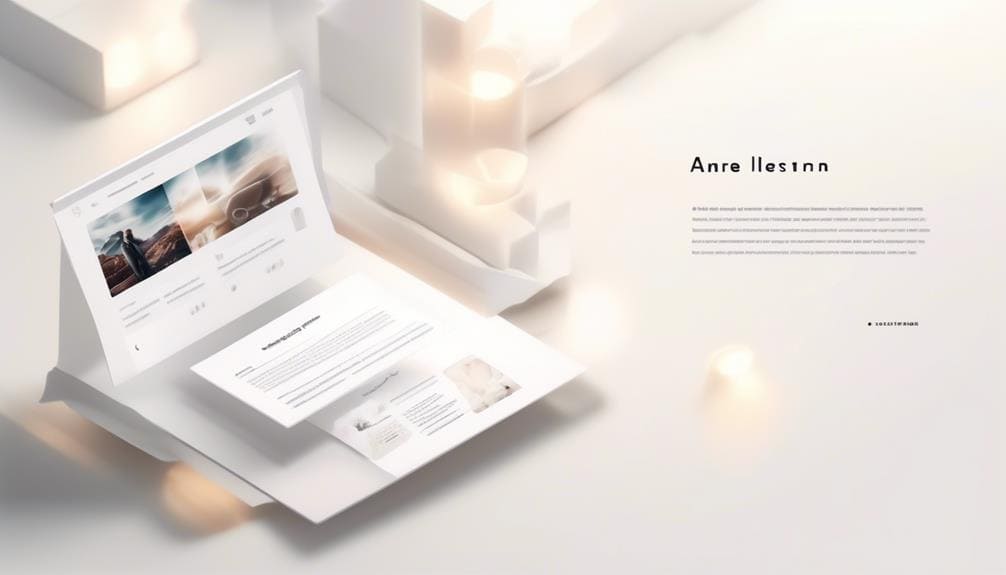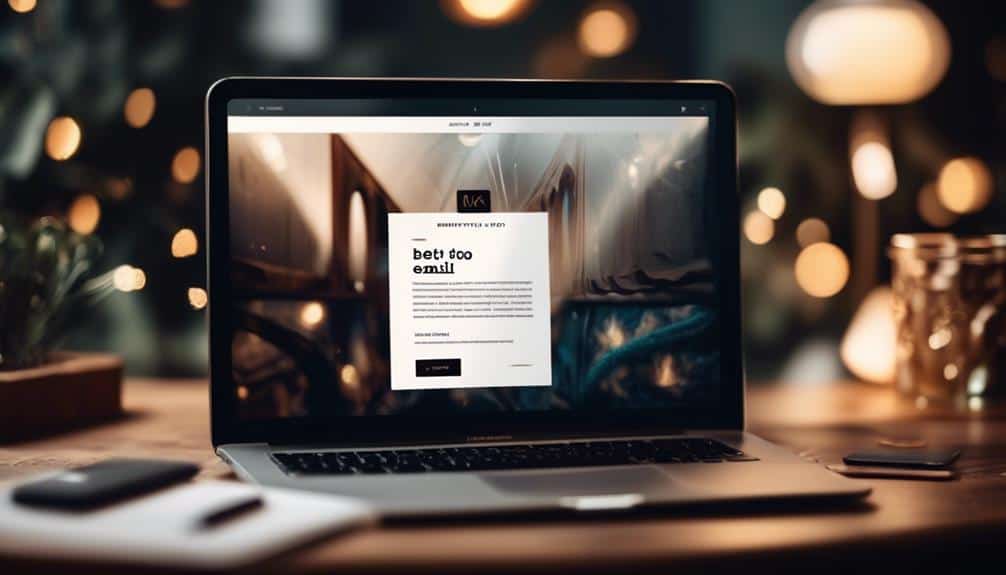Designing Emails That Deliver: Best Practices for Visual and Textual Content
When it comes to crafting emails, think of them as intricate puzzles waiting to be solved. Every piece, from the visual elements to the carefully chosen words, plays a crucial role in engaging your audience and driving action.
As you navigate through the maze of best practices for email design, you'll discover how each element contributes to the overall success of your campaigns.
So, buckle up and get ready to unravel the secrets behind creating emails that not only reach but truly resonate with your recipients.
Key Takeaways
- Incorporate captivating visuals to enhance engagement and cater to shorter attention spans.
- Craft concise and engaging subject lines that are personalized, urgent, and relevant to grab attention.
- Experiment with interactive elements like quizzes and GIFs to boost engagement and drive interaction.
- Continuously A/B test and optimize subject lines for improved open rates and conversion.
Importance of Visual Elements

When designing emails for optimal deliverability, incorporating visually appealing elements can significantly enhance engagement and response rates. Enhancing engagement is key in today's fast-paced digital world. By implementing visual hierarchy techniques, you can guide the reader's eye through the content, ensuring that the most important information stands out.
Visual hierarchy techniques include using bold colors, eye-catching images, and strategic placement of text and graphics. These elements help create a seamless flow within the email, drawing the reader in and keeping them interested. With attention spans getting shorter, captivating visuals are essential to make a lasting impression.
Incorporating dynamic elements like GIFs or interactive buttons can further boost engagement levels. These interactive features encourage recipients to click and explore, increasing the chances of conversion. Remember, a well-designed email not only looks good but also drives action. So, don't underestimate the power of visually appealing elements in your email campaigns.
Crafting Compelling Subject Lines
Crafting compelling subject lines is crucial for grabbing your reader's attention right from their inbox.
You should aim for concise and engaging subject lines that entice recipients to open your emails.
Subject Line Importance
Crafting an irresistible subject line is crucial for boosting open rates and increasing engagement. Personalization, urgency, and relevance are key elements to consider. Use dynamic language to create curiosity and excitement. Experiment with emojis or symbols to stand out in the inbox. Remember, brevity is crucial – aim for around 6-8 words to maximize impact. Analyze data and A/B test different subject lines to see what resonates best with your audience. Stay innovative and continuously refine your approach to drive better results.
Subject lines are your golden ticket to capturing attention and driving action. Make them count by incorporating these strategies and techniques. Your subject line is the first impression – craft it thoughtfully to compel your audience to open your emails and engage with your content.
Engagement Strategies
Boost your email engagement with subject lines that captivate and compel your audience to take action.
To create compelling subject lines, consider incorporating interactive content and storytelling techniques.
Interactive content, such as polls or quizzes, can pique curiosity and encourage recipients to open your emails.
Additionally, using storytelling techniques like creating a sense of urgency or posing a question can entice readers to engage with your email further.
By combining these elements, you can craft subject lines that not only grab attention but also drive interaction and conversion.
Experiment with different approaches to see what resonates best with your audience and watch your email engagement soar.
A/B Testing Tips
To enhance your email engagement, begin by experimenting with different subject line variations through A/B testing. Crafting compelling subject lines is crucial in capturing your audience's attention.
Start by segmenting your email list based on demographics or behavior to tailor subject lines accordingly. Test different approaches such as including emojis, personalization, or urgency to see what resonates best with your audience.
Monitor the conversion rates closely to determine which subject lines drive the most engagement. Remember, the goal is to continuously optimize and refine your subject lines to improve open rates and ultimately boost your email marketing success.
Stay innovative and adapt your strategies based on the insights gained from A/B testing.
Optimizing for Mobile Devices
Optimizing your email designs for mobile devices ensures enhanced user engagement and seamless viewing experiences on various screens. Mobile optimization is crucial for captivating your audience on-the-go. To enhance user experience, focus on responsive design elements that adapt to different screen sizes. Keep your layout simple and easy to navigate, with clear call-to-action buttons that are thumb-friendly for mobile users.
Prioritize the use of concise and engaging content that gets straight to the point. Make sure your text is easy to read on smaller screens by using legible fonts and appropriate font sizes. Visual elements should be optimized for mobile viewing as well, ensuring quick loading times and high-quality images that enhance rather than distract from your message.
Utilizing White Space Effectively

Enhancing user engagement on mobile devices through responsive design elements also involves strategically utilizing white space to optimize readability and visual appeal. When it comes to your email design, finding the right balance and consistency in the use of white space is key. White space isn't just empty space; it provides clarity and allows your content to breathe, making it easier for recipients to digest your message.
Call-to-Action Strategies
Maximizing user engagement in your emails hinges greatly on crafting compelling and strategically placed call-to-action buttons. To ensure your call-to-action strategies are effective, consider the following:
- Button design: Make sure your buttons stand out with contrasting colors and clear, concise text. Experiment with shapes and sizes to draw attention.
- Copywriting techniques: Use action-oriented language that creates a sense of urgency and clearly communicates the benefit of clicking the button. Personalize the copy to resonate with your audience.
- Placement: Position your call-to-action buttons prominently within your email, ideally above the fold, where they're easily visible without scrolling. Test different locations to see what works best for your audience.
- Mobile optimization: Ensure your buttons are easily tappable on mobile devices by making them large enough and providing ample spacing. Test your emails on various devices to guarantee a seamless experience.
Personalization Techniques

Crafting compelling call-to-action buttons is just the beginning when it comes to boosting user engagement; now, let's explore how personalization techniques can take your email campaigns to the next level. Personalization tips can significantly impact the success of your email marketing efforts.
Start by segmenting your email list based on demographics, purchase history, or engagement levels. This allows you to tailor your content to specific groups, increasing relevance and engagement.
Customization strategies like using the recipient's name in the subject line or email body can create a sense of individual attention. Leverage dynamic content to show different product recommendations based on past purchases or browsing behavior.
Utilize automated triggers to send personalized emails based on user actions, such as abandoned cart reminders or special birthday offers. By implementing these personalization techniques, you can enhance user experience, drive conversions, and build stronger relationships with your audience.
A/B Testing for Success
Ready to boost your email performance? Test different designs, track key engagement metrics, and fine-tune your content for optimal results.
A/B testing holds the power to transform your email strategy and drive higher conversions.
It's time to put your emails to the test and watch your success soar.
Test Email Designs
Wondering how A/B testing can boost the success of your email designs? When it comes to testing email designs, there are a few key strategies to keep in mind:
- Vary Email Layout: Experiment with different layouts to see what resonates best with your audience.
- Play with Font Choices: Test out different fonts to find the one that enhances readability and engagement.
- Test Call-to-Action Placement: Try different positions for your CTAs to see which drives the most clicks.
- Explore Color Schemes: Experiment with color combinations to see which ones grab attention and encourage action.
Measure Engagement Metrics
To ensure the success of your email designs, measure engagement metrics through A/B testing for valuable insights on what resonates best with your audience. By conducting engagement analysis and comparing response rates between different email variations, you can pinpoint the most effective design elements and content strategies.
A/B testing allows you to experiment with various visuals, calls to action, subject lines, and personalization techniques to see which ones drive higher engagement levels. Analyzing metrics such as open rates, click-through rates, and conversion rates will help you optimize your email campaigns for maximum impact.
Continuously testing and refining your emails based on engagement data is key to enhancing your communication strategy and achieving better results.
Optimize for Performance
For optimal performance in your email campaigns, leverage A/B testing strategies to refine and enhance your design elements for maximum success. By conducting A/B tests, you can gather valuable insights on what resonates best with your audience and fine-tune your email content accordingly.
To ensure your emails are high-performing and engaging, consider the following:
- Email Segmentation: Tailor your emails to specific audience segments for personalized content.
- Conversion Tracking: Monitor and analyze conversion rates to understand the effectiveness of your email campaigns.
- Subject Line Testing: Experiment with different subject lines to increase open rates.
- Call-to-Action Variation: Test various CTAs to optimize click-through rates and drive desired actions.
Implementing these strategies will help you optimize your email performance and achieve better results.
Frequently Asked Questions
How Can Email Design Impact Brand Perception and Recognition?
When you focus on brand consistency in your email design, it boosts brand perception and recognition. By establishing a strong visual hierarchy that aligns with your brand identity, you create a memorable and impactful experience for your audience.
What Are Some Common Mistakes to Avoid When Designing Email Visuals?
When designing email visuals, avoid clutter to keep your message clear and concise. Ensure consistent branding throughout for instant recognition. These mistakes can hinder engagement and impact your brand's perception negatively.
How Can Email Subject Lines Affect Open Rates and Engagement?
Craft captivating subject lines to boost open rates and engagement. Analyze metrics for insights. Optimize content for relevance. Implement A/B testing for effectiveness. Personalize messages for higher impact. Stay innovative to stand out in crowded inboxes.
What Are Some Key Considerations for Mobile-Friendly Email Design?
When designing for mobile, remember responsive design is key. Opt for larger font sizes for readability. Make sure your emails look great on all devices to engage your audience effectively. Stay ahead with smart design choices.
How Can A/B Testing Help Improve Email Performance and Conversion Rates?
To improve email performance and conversion rates, A/B testing is key. Test different elements like subject lines or call-to-action buttons. Analyze performance metrics and data to optimize for conversion. Use testing strategies for effective conversion optimization.
Conclusion
In conclusion, by implementing best practices for visual and textual content in your email design, you can ensure that your emails stand out, engage your audience, and drive desired actions.
Remember to focus on compelling subject lines, mobile optimization, white space utilization, effective calls-to-action, personalization, and A/B testing.
By consistently incorporating these strategies, you can create emails that deliver results and resonate with your subscribers. Keep experimenting and refining your approach to maximize the impact of your email campaigns.







